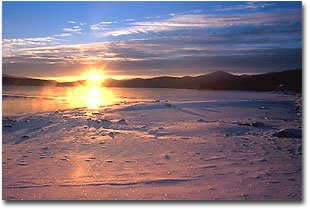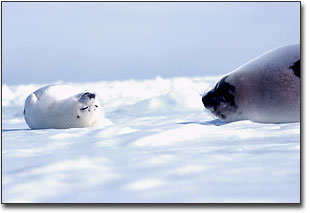|
The Camera Hunter®
Photography and Text Copyright Bill Silliker, Jr.
All rights reserved.
Keep Your Camera Cold
 Hints that winter is on the way falling in parts of Maine tonight provide a not so gentle reminder that it's time to think about keeping your camera running when you're out there having fun in all of that cold. Every year about this time an article in some camera magazine tell folks that the way to do that is to keep their cameras under their jackets and only bring them out to take a picture. That's partly because camera batteries generally perform less efficiently or not at all when exposed to freezing temperatures. It's also partly because the writers of those articles aren't as active as some of the folks who read this online magazine!
Hints that winter is on the way falling in parts of Maine tonight provide a not so gentle reminder that it's time to think about keeping your camera running when you're out there having fun in all of that cold. Every year about this time an article in some camera magazine tell folks that the way to do that is to keep their cameras under their jackets and only bring them out to take a picture. That's partly because camera batteries generally perform less efficiently or not at all when exposed to freezing temperatures. It's also partly because the writers of those articles aren't as active as some of the folks who read this online magazine!
Anyone who snowshoes or cross-country skis knows that when you travel under your own power, you work up a sweat. What do you think happens to your camera if it's under your jacket with all that moisture? And what do you suppose happens when a wet camera meets cold winter air?
You cannot avoid exposing a camera stored beneath your jacket to some moisture if you are an active person. On the wrong day, that moisture can freeze up your zoom lens, screw up your autofocus or fog up your lens surface.
An even worse problem might develop if you shove a camera that's been out in freezing temperatures under a warm jacket or into any other warm place right away. Condensation collects immediately on the body and the lens outer surface and - worst of all - might even form on the inside of the lens barrel itself. Little green things that can etch glass might someday grow on the inside lens surfaces from moisture trapped in the lens barrel.
So how do you keep your camera going when you're out in winter? It's easy. Just keep your camera outside your jacket and let it become as cold as the outdoors. Most modern 35mm cameras will operate just fine, even in sub-zero temperatures, as long as their batteries continue to provide power. Your focus - pun intended - should be how to keep your batteries working, not how to keep your camera warm.
Keep Your Powder Dry

Several ways exist to do just that. The easiest and cheapest method is to keep a spare set of the batteries that your camera requires in a pants or shirt pocket. Be sure to wipe off any moisture before you put them in your camera.
A better way is to use the rechargeable nickel metal hydride, nickel metal cadmium (nicads) or other reusable battery products designed by the camera manufacturer of your chosen equipment. Many models of modern cameras have rechargeable batteries available that work for a long time, even in sub-zero temperatures.
You can also buy generic batteries that perform well in the cold. Lithium or rechargeable nicad battery sizes are available that will fit many camera models. Lithium batteries perform better than alkaline batteries in lower temperatures but are not rechargeable.
Rechargeable AA size nicads which fit many cameras are available at Radio Shack and many hardware stores. Be sure to check your camera manual first about the use of such batteries if you decide to go with generic rechargeables, as voltage differences might make a difference in proper operation.
But no matter the battery type you use, for the average winter day, keep a spare set warm and you should be able to shoot when you want to.
If it's really cold, well below zero, I also take the batteries out of my camera and keep them warm in a pocket until needed for shooting. That method - first developed out of necessity while on a seven mile hike in 20 below zero weather in Baxter State Park in Maine - gives you two chances to keep your camera going.
What happens if your camera dies because the batteries did get too cold? Try taking them out and warm them up in your pocket. If you have a camera that has only a tiny battery to operate its meter, you can sometimes warm that up by rubbing it between your hands for a few minutes.
When You're Done
You should always bring your camera up to temperature gradually when you come in from the cold.
If you're getting in a car, at the very least put your camera gear in the back seat and cover it with something to protect it from the heater. I put my cameras inside a waterproof plastic case so that they're not exposed to condensation as they warm up gradually. A tightly sealed plastic trash bag works just as well, by collecting condensation on the outside of the bag.
And as always, catch yours in the good light.
BS-NPN 012
Comments on Bill Silliker, Jr.'s The Camera Hunter articles? Send them to the editor.
Maine wildlife & nature photographer Bill Silliker, Jr. – The Mooseman - photographed at many wild places in North America, with the results published in magazines internationally and in 9 of his own books. Bill was an instructor of wildlife and nature photography for L. L. Bean's Outdoor Discovery Program and a member of the Fuji Film Talent Team. Read more about Bill on the Camera Hunter archives page.


| 


